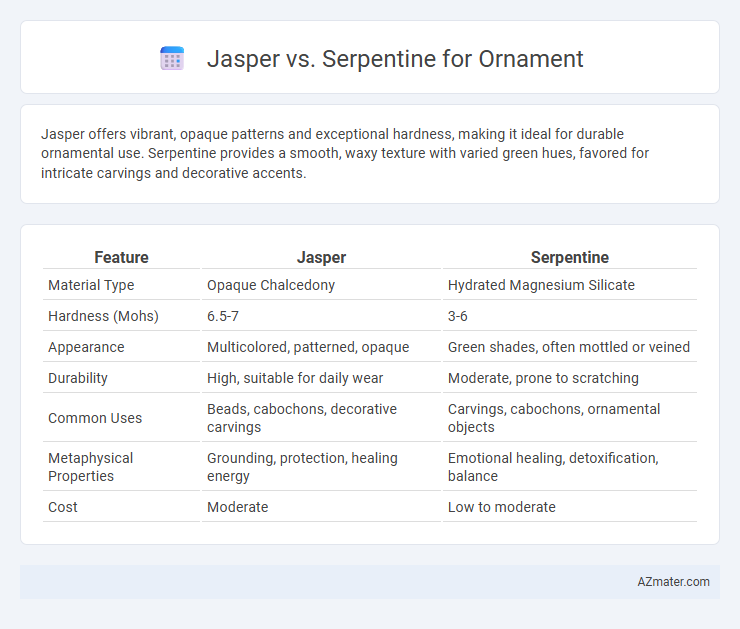Jasper offers vibrant, opaque patterns and exceptional hardness, making it ideal for durable ornamental use. Serpentine provides a smooth, waxy texture with varied green hues, favored for intricate carvings and decorative accents.
Table of Comparison
| Feature | Jasper | Serpentine |
|---|---|---|
| Material Type | Opaque Chalcedony | Hydrated Magnesium Silicate |
| Hardness (Mohs) | 6.5-7 | 3-6 |
| Appearance | Multicolored, patterned, opaque | Green shades, often mottled or veined |
| Durability | High, suitable for daily wear | Moderate, prone to scratching |
| Common Uses | Beads, cabochons, decorative carvings | Carvings, cabochons, ornamental objects |
| Metaphysical Properties | Grounding, protection, healing energy | Emotional healing, detoxification, balance |
| Cost | Moderate | Low to moderate |
Overview of Jasper and Serpentine as Ornamental Stones
Jasper, known for its rich variety of colors and intricate patterns, is a durable and opaque quartz used extensively in ornamental art and jewelry. Serpentine exhibits a smooth texture and distinctive green hues, valued for its softness and ease of carving in decorative objects and architectural elements. Both stones offer unique aesthetic qualities, with jasper prized for vivid visual complexity and serpentine favored for its elegant, natural shades and tactile appeal.
Physical Appearance: Jasper vs Serpentine
Jasper displays a wide variety of colors, including red, brown, yellow, and green, often exhibiting unique patterns such as bands or spotted formations, making it visually striking for ornamental use. Serpentine typically features a smooth, waxy texture with shades ranging from deep green to olive and sometimes yellow or black, offering a more uniform and muted appearance compared to Jasper. The distinct color diversity and pattern complexity of Jasper contrast sharply with the often solid and subdued hues of Serpentine, influencing their selection in decorative applications.
Color Variations and Patterns
Jasper exhibits a wide range of color variations including deep reds, browns, yellows, and greens, often featuring unique patterns like speckles, bands, or swirls that enhance its ornamental appeal. Serpentine typically displays shades of green, from olive to emerald, with smooth, sometimes mottled or fibrous patterns that resemble snake skin, offering a distinct texture for decorative use. Both stones provide diverse aesthetic options, but Jasper's richly varied hues and intricate patterns make it especially favored for vibrant and detailed ornamental designs.
Historical and Cultural Uses
Jasper and Serpentine have both been prized for their ornamental value throughout history, with Jasper frequently utilized in ancient Egyptian jewelry and carvings for its vibrant colors and durability. Serpentine, often associated with East Asian cultures, was historically fashioned into intricate amulets and architectural elements due to its smooth texture and rich green hues. Both gemstones carry significant cultural symbolism, with Jasper representing protection and healing, while Serpentine is believed to attract wealth and ward off negative energies.
Durability and Suitability for Ornaments
Jasper is highly durable with a Mohs hardness of 6.5-7, making it resistant to scratches and ideal for long-lasting ornamental pieces. Serpentine, with a lower hardness of 3-6, is softer and more prone to damage, limiting its suitability for frequently handled ornaments. Jasper's toughness and vibrant colors ensure it remains a preferred choice for durable, visually striking jewelry and decorative items.
Ease of Carving and Shaping
Jasper is a dense, fine-grained gemstone that offers moderate ease of carving due to its hardness, typically around 6.5 to 7 on the Mohs scale, allowing detailed ornament work but requiring specialized tools. Serpentine, softer with a Mohs hardness of 2.5 to 4, is significantly easier to carve and shape, making it ideal for intricate designs and beginner craftsmen. The choice between jasper and serpentine depends on the balance between desired detail precision and carving difficulty for ornamental projects.
Popular Types of Ornaments Made
Jasper and serpentine are popular choices for ornamental carvings and jewelry due to their unique colors and patterns. Jasper, with its rich red, yellow, and brown hues, is often used for beads, cameos, and cabochons, prized for its durability in intricate designs. Serpentine, recognized for its green shades and smooth texture, is commonly carved into figurines, decorative tiles, and small sculptures, making it a favored material in ornamental art.
Care and Maintenance Requirements
Jasper ornaments require minimal care, needing only occasional dusting with a soft cloth to maintain their polished appearance and prevent surface scratches. Serpentine, being softer and more prone to weathering, demands more delicate handling, including gentle cleaning with mild soap and water and avoiding prolonged exposure to acidic or abrasive substances. To preserve the intricate patterns and prevent damage, both stones benefit from stored environments free of extreme temperature fluctuations and direct sunlight.
Price Comparison and Market Availability
Jasper offers a more affordable price range, typically between $5 to $20 per piece, making it accessible for budget-conscious ornament buyers, while Serpentine can range from $15 to $50 due to its rarity and unique green shades. Market availability favors Jasper with widespread sourcing from Brazil, India, and Russia, ensuring steady supply in both physical stores and online platforms. Serpentine, being less common, is often limited to specialty mineral shops or custom orders, leading to a more fluctuating market presence.
Choosing Between Jasper and Serpentine for Ornamentation
Jasper and serpentine both offer unique aesthetic qualities for ornamentation, with jasper prized for its rich, opaque patterns and vibrant earth tones, while serpentine is valued for its smooth texture and varying shades of green. Choosing between jasper and serpentine depends on desired durability, as jasper is harder and more resistant to scratches, making it ideal for jewelry and decorative objects that endure frequent handling. Serpentine's softer nature and attractive color variations suit intricate carvings and architectural details, providing an elegant, natural look in ornamental designs.

Infographic: Jasper vs Serpentine for Ornament
 azmater.com
azmater.com